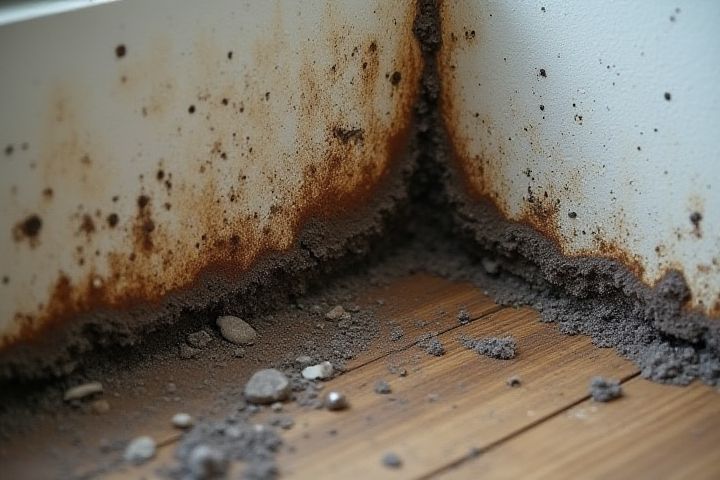
Dampness in houses is primarily caused by inadequate ventilation, which leads to the accumulation of moisture in the air. Poor insulation can exacerbate this issue, allowing cold surfaces to attract humidity, resulting in condensation. Leaks from roofs, walls, or plumbing systems introduce excess water, contributing to damp surfaces and mold growth. Ground moisture seeping through foundations and walls can also lead to rising dampness, especially in areas with high water tables. To mitigate these effects, maintaining proper air circulation and investing in quality waterproofing solutions are essential for preserving your home's integrity.
What Causes Dampness In Houses
Poor ventilation
Poor ventilation is a leading cause of dampness in houses, resulting in trapped moisture and humidity levels rising above 60%. Inadequate air circulation prevents the exchange of fresh air, allowing condensation to form on cold surfaces such as walls and windows. Over time, this excess moisture can lead to mold growth, timber decay, and respiratory issues for occupants. Ensuring proper ventilation, such as installing extractor fans and opening windows regularly, can significantly reduce dampness and improve indoor air quality.
Rising damp
Rising damp occurs when moisture from the ground moves upward through a building's walls via capillary action. This phenomenon typically affects older structures lacking an effective damp-proof course, allowing groundwater to infiltrate porous materials like brick and masonry. Signs of rising damp include peeling paint, crumbling plaster, and a distinct musty odor--often detected within the lower sections of walls. To mitigate rising damp, you can implement solutions such as installing a new damp-proof barrier, improving drainage around the property, and ensuring proper ventilation to reduce indoor humidity levels.
Condensation buildup
Condensation buildup in houses primarily occurs when warm, moist air comes into contact with cool surfaces, resulting in water droplets forming on walls, windows, and ceilings. This phenomenon is particularly prevalent in poorly ventilated areas, where humidity levels can reach 60% or higher, especially during colder months or in kitchens and bathrooms. Inadequate insulation can further exacerbate this issue, as cooler indoor surfaces facilitate condensation. Managing indoor humidity levels below 50% through proper ventilation and the use of dehumidifiers can significantly reduce the risk of condensation and the subsequent dampness it causes.
Leaking pipes
Leaking pipes are a significant cause of dampness in houses, often leading to moisture accumulation in walls and floors. When pipes, particularly those carrying water or waste, develop cracks or loose fittings, they can release water into surrounding areas, creating ideal conditions for mold and mildew growth. This unwanted moisture can seep into structural components, weakening the integrity of your home and fostering an unhealthy living environment. Regular inspections and prompt repairs of plumbing systems are essential in preventing damp-related issues linked to leaking pipes.
Roof leaks
Roof leaks are a prominent cause of dampness in houses, often resulting from several factors such as damaged shingles, loose flashing, or blocked gutters. Research indicates that over 70% of leaking roofs stem from wear and tear due to aging materials or severe weather conditions. When water seeps through compromised sections of the roof, it can lead to structural damage, mold growth, and an increase in indoor humidity levels that can affect your health. Preventative measures, such as regular roof inspections and timely repairs, can significantly reduce the likelihood of leaks and subsequent dampness in your home.
Inadequate insulation
Inadequate insulation allows outside moisture to permeate through walls and roofs, leading to dampness in your home. Poorly insulated areas, especially attics and basements, create a conducive environment for humidity to build up, resulting in condensation. This excess moisture can promote mold growth and damage building materials, escalating repair costs. Ensuring proper insulation not only controls dampness but also enhances energy efficiency and overall indoor comfort.
Blocked gutters
Blocked gutters can significantly contribute to dampness in houses by preventing proper water drainage. When gutters accumulate debris such as leaves, twigs, and dirt, they become ineffective at channeling rainwater away from the roof and foundation. This overflow can lead to water pooling on the surface, increasing humidity levels and allowing moisture to seep into walls, basements, and crawlspaces. Regular maintenance of your gutters is essential to mitigate these risks and protect your home from damp-related issues like mold growth and structural damage.
Groundwater infiltration
Groundwater infiltration is a primary cause of dampness in houses, particularly in areas with high water tables or poor drainage systems. When groundwater levels rise, moisture can seep into basements and crawl spaces, leading to elevated humidity levels and potential mold growth. Poorly sealed foundations, cracks in basement walls, and unprotected soil around the structure can exacerbate this issue, permitting moisture entry. Implementing proper drainage solutions, such as French drains or sump pumps, can significantly reduce your risk of dampness caused by groundwater infiltration.
Faulty damp-proof course
A faulty damp-proof course (DPC) can lead to significant dampness within houses, as it acts as a barrier to prevent moisture from rising through walls. When the DPC is improperly installed or damaged, it allows groundwater to seep into the structure, causing rising damp. This type of moisture intrusion can result in areas of mold growth, compromised structural integrity, and damage to interior finishes, potentially leading to repair costs exceeding PS5,000 in severe cases. Regular inspections of your property's damp-proofing system are essential to ensure it functions effectively, protecting your home from moisture-related issues.
High humidity levels
High humidity levels, often exceeding 60%, are a primary contributor to dampness in houses. Poor ventilation systems can trap moisture indoors, exacerbating the situation, particularly in areas like bathrooms and kitchens. Surfaces such as walls and ceilings can develop mold, leading to health issues and structural damage if untreated. To mitigate this, using dehumidifiers or improving airflow can help maintain humidity levels below the recommended threshold of 50%.
